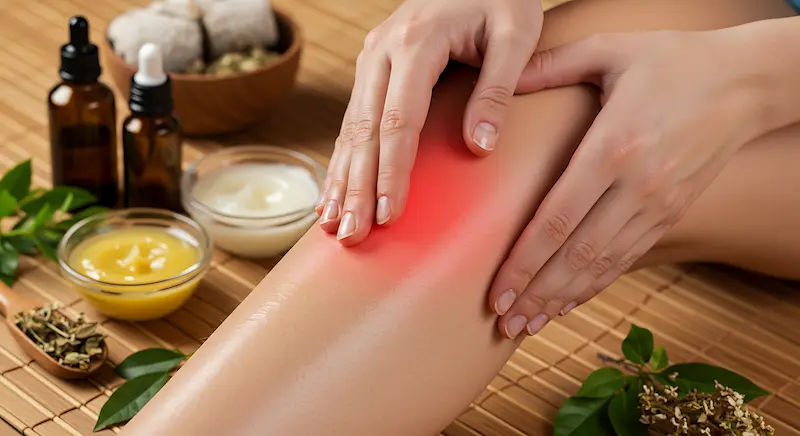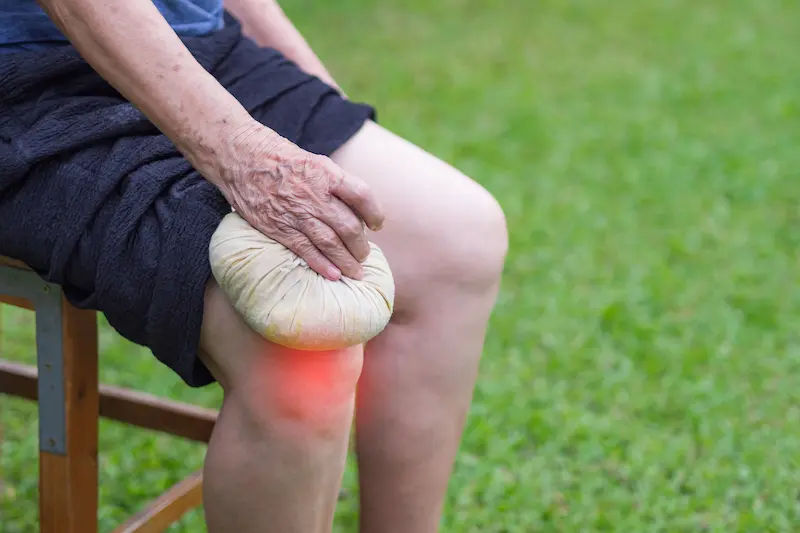Understanding Knee Pain and Arthritis: Causes and Solutions
The article discusses knee pain and arthritis, their causes, symptoms, and treatment in detail. Read to know how to support knee health for an active lifestyle.

Written by
Last updated on 3rd Jul, 2025
Introduction
The knees are perhaps the most used joints in our bodies. They bear the weight of our movements and support our daily activities. However, when joints become painful, even simple daily tasks appear to become challenges. This is especially true for arthritis, a common musculoskeletal condition that causes inflammation in the joints.
While arthritis can affect any joint, it mostly affects the knees. If you have this condition, you will feel pain, discomfort, swelling, and poor flexibility. While osteoarthritis results from the natural wear and tear of cartilage as you age, rheumatoid arthritis occurs when your immune system becomes overactive. By understanding the connection between knee pain and arthritis, you can find ways to address the root causes and follow steps that will help you support your joint health.
Types of Arthritis Affecting the Knee
Arthritis in the knee can manifest in different forms, each with distinct causes and symptoms. Understanding these types can help you in identifying the right treatment approach.
1. Osteoarthritis
Osteoarthritis is the most common type of arthritis in the knees and is often described as a "wear-and-tear" condition. Osteoarthritis develops when the protective cartilage that cushions the ends of of your knee bones begins to wear down, causing pain, stiffness, and a grating sensation when you use the joint. Although this degenerative condition is usually associated with age, it can also be caused by being overweight, or due to repetitive pressure on the joint.
2. Rheumatoid Arthritis
Rheumatoid arthritis (RA) is an autoimmune disease in which the immune system of the body erroneously attacks the synovial lining of the joints, resulting in inflammation and destruction. RA, on the other hand, is a more serious condition that primarily affects multiple joints and usually occurs symmetrically along with symptoms such as fatigue and swelling, unlike osteoarthritis. In this case, early diagnosis and treatment are very important to avoid permanent damage.
3. Post-traumatic Arthritis
This type of arthritis occurs after sustaining a major injury to the knee, such as a fracture, ligament tear, or cartilage damage. The trauma, over time, continues to affect the mechanics of the joint thus progressing the wear-and-tear of cartilage and leading to inflammation. Even knee trauma that appears to have healed properly can leave behind residual damage that manifests years later in the form of post-traumatic arthritis, underscoring the importance of appropriate recovery and rehabilitation.
Causes of Knee Pain in Arthritis
Knee pain triggered by arthritis is a result of a combination of structural and inflammatory changes in your knee joint. The primary factors that contribute to this discomfort are explained as such:
1. Inflammation
Inflammation in joints is a characteristic feature of arthritis, especially rheumatoid arthritis. The immune system attacks the synovial lining, resulting in swelling, redness, and tenderness around the knee. If not treated — this inflammatory reaction not only causes pain but can also speed up the joint damage as well.
2. Cartilage Degeneration
With osteoarthritis, cartilage — the cushioning tissue that covers the ends of bones — wears down, eventually leaving bones to rub against one another. This friction can result in stiffness, pain, and a grating sensation with movement. The degeneration of cartilage is typically accelerated by factors such as age, obesity, or misaligned joints.
3. Injury or Overuse
Prior injuries to the knee or repetitive stress through overuse can play a major role in the development of arthritis-related knee pain. Injury, like ligament tears or fractures, can change the mechanics of a joint making it more vulnerable to degeneration. The changes that take place over time can manifest as post-traumatic arthritis, chronic pain, and stiffness.
Risk Factors for Developing Knee Arthritis
Some risk factors may put you at a higher risk of getting arthritis in the knees. Identifying these risks early on can help in prevention and early management.
1. Age and Gender
Aging is one of the strongest risk factors for knee arthritis, particularly osteoarthritis. As we age, the more wear-and-tear the cartilage has to endure, leading to an increased risk of joint problems. Gender also plays a role— women, and in particular, post-menopausal women, have an increased risk of developing arthritis, possibly due to hormonal factors that affect the joints.
2. Genetics
Family background is a big risk factor for arthritic diseases. Some aspects of genetics can affect cartilage structure, immune function, and inflammation— all of which are involved in arthritis.
3. Weight and Lifestyle
Having extra pounds can put extra pressure on your knees, leading to more wear and tear of the cartilage and a higher risk of osteoarthritis. A sedentary lifestyle and lack of physical activity can weaken the muscles that help stabilise the knees, leading to poor joint stability. On the other hand, repeated stress from high-impact movements can also lead to progressive damage to the joints.
Symptoms of Knee Arthritis
Knee arthritis manifests in the form of a range of symptoms that can interfere with mobility and overall quality of life. It helps to be able to identify these signs early on so that intervention can take place at the appropriate time.
1. Pain and Stiffness
Persistent pain, particularly after exercise or after a resting period, is a common symptom. Pain is often accompanied by stiffness, particularly in the morning or after a long period of sitting, which causes discomfort during movement.
2. Swelling and Reduced Mobility
Inflammation of the joint leads to swelling around the knee that can be seen and might also be warm and tender to the touch. The swelling, together with the joint damage, typically decreases the range of motion of the knee, leading to pain in activities like climbing stairs or walking.
3. Crepitus and Knee-locking
Crepitus is the grinding or cracking feeling felt with knee motion, caused by the loss of smooth cartilage and bone friction. In later stages, the knee may lock or collapse without warning, caused by joint instability or the interruption of joint movement by debris from damaged cartilage.
Diagnosing Knee Arthritis
Diagnosis of knee arthritis is essential to initiate the proper treatment. Diagnosis is often made via clinical assessment, imaging, and blood tests.
1. Clinical Examination
This process usually starts with a detailed clinical assessment. A doctor goes through the patient's medical history, symptoms, and lifestyle. Generally, a physical examination is conducted to recognise pain points, swelling, joint stiffness, and range of motion. If walking abnormalities arise from knee problems, gait analysis may also be performed.
2. Imaging Tests
Imaging methods such as X-ray and MRI scan gives an in-depth vision of the anatomical structure of the knee joint. X-rays show cartilage loss, bone spurs, or narrowing of the joint space—all signs of osteoarthritis. Alternatively, MRIs (magnetic resonance imaging) provide a more detailed view of soft tissue, including cartilage, tendons, and ligaments, making them helpful in determining rheumatoid or post-traumatic arthritis.
3. Laboratory Tests
Lab tests can help identify inflammatory or autoimmune causes of knee arthritis. Rheumatoid arthritis can be diagnosed with blood tests for rheumatoid factor (RF) and anti-CCP antibodies. CRP level also plays a role in the diagnosis. Analysis of joint fluid may also be performed to identify infections or crystal deposits associated with some forms of arthritis.
Treatment Options For Knee Arthritis
Knee arthritis is generally managed holistically. Management may depend on the severity of the condition. The tactics vary from using medications to surgical intervention, to mitigate clinical symptoms and improve joint function.
1. Medications
Typically, medications are the first step in treating knee arthritis. Non-steroidal anti-inflammatory anti-inflammatory drugs (NSAIDs) such as ibuprofen, can ease pain and inflammation, and corticosteroid injections can offer temporary relief during acute flare-ups. In rheumatoid arthritis, disease-modifying antirheumatic drugs (DMARDs) are used to regulate the immune system to prevent further damage to the joints. Some supplements and medications, such as glucosamine and chondroitin, may help maintain joint health.
2. Physical Therapy
Physical therapy can be really helpful in strengthening your knee and improving its mobility. Targeted exercises focus on building the muscles surrounding your knee to enhance support to the joint. Other techniques, including hydrotherapy, ultrasound therapy, or the use of supportive devices like braces, can help you minimise stress on the knee and improve overall movement.
3. Surgical Options
In advanced cases where non-surgical treatments fail to offer relief, surgery may be required. Arthroscopic procedures are usually performed to treat minor knee joint issues, while partial or total knee replacement is recommended for significant joint degeneration. For younger patients with structural imbalances, the knee can be realigned through a procedure called osteotomy.
Lifestyle and Home Remedies
Certain lifestyle changes and proven home remedies can help you ease the symptoms of Knee Arthritis and support your joint health.
1. Diet and Nutrition
A proper diet that includes anti-inflammatory foods may potentially help minimise the symptoms of knee arthritis. You should consume foods rich in omega-3 fatty acids such as fish, flaxseeds, and walnuts to reduce inflammation. Berries, spinach, and broccoli are antioxidant-rich fruits and vegetables which may also help promote joint health. You can also try to reduce inflammation in the body and joints by cutting down on processed foods, sugar, and saturated fats.
2. Exercise and Weight Control
Low-impact exercises, such as swimming, walking, and yoga, can help strengthen the muscle groups around your knee and improve flexibility. Maintaining a healthy weight can help reduce the stress on knee joints and prevent cartilage from wearing down faster. To further enhance your joint stability and range of motion, you can practise stretching and strengthening exercises.
3. Alternative Therapies
Conventional treatments can be complemented with alternative therapies such as Ayurveda, acupuncture, or massage therapy. Ayurvedic herbal preparations may help reduce inflammation and pain. Similarly, hot and cold compresses may offer temporary relief by calming pain. Mind-body practices like meditation or tai chi can also help reduce stress, a factor that can worsen arthritis symptoms.
Coping and Support
While living with knee arthritis can be difficult, you can address some of the challenges by building a strong support system and through the usage of adaptive tools to support your daily life and emotional well-being.
1. Support Groups and Counselling
You should connect and bond with other individuals struggling with similar challenges. This will help provide you with valuable emotional support. In-person and online support groups offer a safe space to share your experiences, learn about new coping strategies, and gather encouragement. Counselling and therapy can also help in healing the emotional toll of arthritis. You can also engage with a mental health professional who will provide you with tools and techniques to stay positive and focused on long-term goals.
2. Adaptive Aids and Tools
With adaptive aids, you can make everyday tasks easier and reduce stress on your knees. Simple equipment like walking sticks, knee braces, or orthopaedic shoes can be of great help in providing additional joint support and improving mobility. Grab bars, raised toilet seats, or ergonomic chairs at home can also support comfort and safety.
Conclusion
Knee arthritis is a complex health issue that can affect your daily life. But with a complete understanding of its different types, causes, symptoms, treatment, and management techniques, you can take control of your knee health.
Osteoarthritis, rheumatoid arthritis, and post-traumatic arthritis are the most common types of arthritis that affect the knee. All these types present unique challenges. You can effectively manage the condition by recognising the signs such as pain, stiffness, and swelling early. Depending on your condition and requirements, treatment options for knee arthritis will vary from medications and physical therapy to lifestyle changes and surgery.
With early diagnosis and treatment, you can successfully limit the progression of arthritis and minimise damage to your joints. Regenerative therapies like stem cell applications and cartilage regeneration techniques are some of the promising new advancements that will one day offer improved treatment outcomes. By staying informed and proactive, you can overcome the challenges posed by knee arthritis with confidence, ensuring better mobility, reduced pain, and an active, fulfilling life.
Consult Top Orthopaedician
Consult Top Orthopaedician

Dr Vikas P Birla
Orthopedics-Sports Medicine
13 Years • MBBS, DNB, MNAMS, Fellowship in Shoulder and Sports Injury
Delhi
Apollo Hospitals Indraprastha, Delhi

Dr. Vivek Kumar N Savsani
Orthopaedician
8 Years • MBBS, MS Ortho
Bengaluru
Apollo Clinic, JP nagar, Bengaluru

Dr. Manjunath Giriyappa
Orthopaedician
9 Years • MBBS , MS (Orthopedics)
Bengaluru
Unicorn Multi-Speciality Clinic, Bengaluru

Dr. Mithun Oswal
Orthopaedician
13 Years • MBBS, MS Orthopaedics
Bangalore
Parshwa Ortho and Womens Care Centre, Bangalore
(25+ Patients)

Dr. Pradeep Lucas
Orthopaedician
7 Years • MBBS, Diploma in Orthopaedics, Fellowship in DFSI
Bengaluru
Revival Multispeciality Clinic, Bengaluru


.webp)

